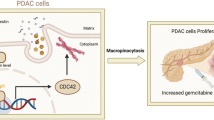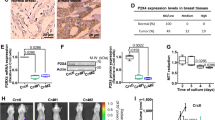Abstract
The lysosomal protease Cathepsin D (Cath D) is associated with increased invasiveness and metastasis in breast cancer. Both estrogen and tamoxifen have been reported to increase Cath D, which seems to contradict the efficacy of tamoxifen as an adjuvant for estrogen dependent breast cancer. Cath D is bioactive in the extracellular space but very little is known about hormonal regulation of secreted Cath D in vivo. In this study we used microdialysis to sample the extracellular fluid in estrogen receptor positive MCF-7 tumors in nude mice. We show that tamoxifen in combination with estradiol decreased secreted Cath D compared with estradiol treatment only in solid tumors in situ. Cell culture of MCF-7 cells revealed that estradiol and tamoxifen increased intracellular proteolytic activity of Cath D in a similar fashion whereas secretion of Cath D was increased by estradiol and inhibited by tamoxifen. Immunofluorescence showed that estradiol located Cath D to the cell surface, while tamoxifen accumulated Cath D to dense lysosomes in perinuclear regions. Moreover, tamoxifen increased the intracellular transporter of Cath D, the mannose 6-phosphate/IGF-II receptor (M6P/IGF2R). In contrast, estradiol decreased the levels of this receptor. Thus, secretion of Cath D is hormone dependent and may be mediated by altered expression of the M6P/IGF2R. Our results highlight the importance of measurements of proteins in all compartments where they are biological active and show that microdialysis is a viable technique for sampling of Cath D in vivo.
Similar content being viewed by others

References
Ries LAG, Eisner MP, Kosary CL, Hankey BF, Miller BA, Clegg L, Edwards BK: SEER Cancer Statistics Review, 1973-1998, 2001
Duffy MJ: The role of proteolytic enzymes in cancer invasion and metastasis. Clin Exp Metastasis 10: 145–155, 1992
Spyratos F, Maudelonde T, Brouillet JP, Brunet M, Defrenne A, Andrieu C, Hacene K, Desplaces A, Rouesse J, Rochefort H: Cathepsin D: an independent prognostic factor for metastasis of breast cancer. Lancet 2: 1115–1118, 1989
Westley BR, May FE: Cathepsin D and breast cancer. Eur J Cancer 32A: 15–24, 1996
Rochefort H: Cathepsin D in breast cancer. Breast Cancer Res Treat 16: 3–13, 1990
Rochefort H, Garcia M, Glondu M, Laurent V, Liaudet E, Rey JM, Roger P: Cathepsin D in breast cancer: mechanisms and clinical applications, a 1999 overview. Clin Chim Acta 291: 157–170, 2000
Capony F, Rougeot C, Montcourrier P, Cavailles V, Salazar G, Rochefort H: Increased secretion, altered processing, and glycosylation of pro-cathepsin D in human mammary cancer cells. Cancer Res 49: 3904–3909, 1989
von Figura K, Hasilik A: Lysosomal enzymes and their receptors. Annu Rev Biochem 55: 167–193, 1986
Gieselmann V, Pohlmann R, Hasilik A, Von Figura K: Biosynthesis and transport of cathepsin D in cultured human fibroblasts. J Cell Biol 97: 1–5, 1983
Riley LB, Lange MK, Browne RJ, Cochrane PJ, Choi IJ, Davis B, Arcona S, Alhadeff JA: Analysis of cathepsin D in human breast cancer: usefulness of the processed 31 kDa active form of the enzyme as a prognostic indicator in node-negative and node-positive patients. Breast Cancer Res Treat 60: 173–179, 2000
Tedone T, Correale M, Barbarossa G, Casavola V, Paradiso A, Reshkin SJ: Release of the aspartyl protease cathepsin D is associated with and facilitates human breast cancer cell invasion. FASEB J 11: 785–792, 1997
Garcia M, Platet N, Liaudet E, Laurent V, Derocq D, Brouillet JP, Rochefort H: Biological and clinical significance of cathepsin D in breast cancer metastasis. Stem Cells 14: 642–650, 1996
Rochefort H, Capony F, Garcia M: Cathepsin D in breast cancer: from molecular and cellular biology to clinical applications. Cancer Cells 2: 383–388, 1990
Early Breast Cancer Trialists' Collaborative Group: Ovarian ablation in early breast cancer: overview of the randomised trials. Lancet 348: 1189–1196, 1996
Collaborative Group on Hormonal Factors in Breast Cancer: Breast cancer and hormone replacement therapy: collaborative reanalysis of data from 51 epidemiological studies of 52,705 women with breast cancer and 108,411 women without breast cancer. Lancet 350: 1047–1059, 1997
Couissi D, Dubois V, Remacle C, Schonne E, Trouet A: Western immunoblotting and enzymatic activity analysis of cathepsin D in human breast cancer cell lines of different invasive potential. Regulation by 17beta-estradiol, tamoxifen and ICI 182,780. Clin Exp Metastasis 15: 349–360, 1997
Maudelonde T, Domergue J, Henquel C, Freiss G, Brouillet JP, Simony J, Pujol H, Rochefort H: Tamoxifen treatment increases the concentration of 52K-cathepsin D and its precursor in breast cancer tissue. Cancer 63: 1265–1270, 1989
Chalbos D, Philips A, Galtier F, Rochefort H: Synthetic antiestrogens modulate induction of pS2 and cathepsin-D messenger ribonucleic acid by growth factors and adenosine 3',5'-monophosphate in MCF7 cells. Endocrinology 133: 571–576, 1993
Westley B, May FE, Brown AM, Krust A, Chambon P, Lippman ME, Rochefort H: Effects of antiestrogens on the estrogen-regulated pS2 RNA and the 52-and 160-kiloDalton proteins in MCF7 cells and two tamoxifen-resistant sublines. J Biol Chem 259: 10030–10035, 1984
Westley B, Rochefort H: A secreted glycoprotein induced by estrogen in human breast cancer cell lines. Cell 20: 353–362, 1980
Barret AJ: Cathepsin D and other carboxyl proteinases. In: Proteases in Mammalian Cells and Tissue. Elsevier/North-Holland Biomedical Press, The Netherlands, 1977
Labarca C, Paigen K: A simple rapid and sensitive DNA assay procedure. Anal Biochem 102: 344–352, 1980
Lowry OH, Rosebrough NJ, Farr AL, Randall RJ: Protein measurement with the folin phenol reagent. J Biol Chem 193: 265–273, 1951
Leto G, Tumminello FM, Gebbia N, Rausa L: Kinetics of in vivo inhibition of tissue cathepsin D by pepstatin A. Int J Biochem 20: 917–920, 1988
Brunk UT, Dalen H, Roberg K, Hellquist HB: Photo-oxidative disruption of lysosomal membranes causes apoptosis of cultured human fibroblasts. Free Radic Biol Med 23: 616–626, 1997
Schultz DC, Bazel S, Wright LM, Tucker S, Lange MK, Tachovsky T, Longo S, Niedbala S, Alhadeff JA: Western blotting and enzymatic activity analysis of cathepsin D in breast tissue and sera of patients with breast cancer and benign breast disease and of normal controls. Cancer Res 54: 48–54, 1994
Tannock IF, Rotin D: Acid pH in tumors and its potential for therapeutic exploitation. Cancer Res 49: 4373–4384, 1989
Martinez-Zaguilan R, Lynch RM, Martinez GM, Gillies RJ: Vacuolar-type H(+)-ATPases are functionally expressed in plasma membranes of human tumor cells. Am J Physiol 265(4Pt 1): C1015–C1029, 1993
Boyer MJ, Tannock IF: Regulation of intracellular pH in tumor cell lines: influence of microenvironmental conditions. Cancer Res 52: 4441–4447, 1992
Heuser J: Changes in lysosome shape and distribution correlated with changes in cytoplasmic pH. J Cell Biol 108: 855–864, 1989
Kenessey A, Nacharaju P, Ko LW, Yen SH: Degradation of tau by lysosomal enzyme cathepsin D: implication for Alzheimer neurofibrillary degeneration. J Neurochem 69: 2026–2038, 1997
Tandon AK, Clark GM, Chamness GC, Chirgwin JM, McGuire WL: Cathepsin D and prognosis in breast cancer. N Engl J Med 322: 297–302, 1990
Garvin S, Dabrosin C: Tamoxifen inhibits secretion of vascular endothelial growth factor in breast cancer in vivo. Cancer Res 63: 8742–8748, 2003
Dabrosin C: Variability of vascular endothelial growth factor in normal human breast tissue in vivo during the menstrual cycle. J Clin Endocrinol Metab 88: 2695–2698, 2003
Dabrosin C, Margetts PJ, Gauldie J: Estradiol increases extracellular levels of vascular endothelial growth factor in vivo in murine mammary cancer. Int J Cancer 107: 535–540, 2003
Dabrosin C, Hallstrom A, Ungerstedt U, Hammar M: Microdialysis of human breast tissue during the menstrual cycle. Clin Sci (Lond) 92: 493–496, 1997
Johnson MD, Westley BR, May FE: Oestrogenic activity of tamoxifen and its metabolites on gene regulation and cell proliferation in MCF-7 breast cancer cells. Br J Cancer 59: 727–738, 1989
Krishnan V, Wang X, Safe S: Estrogen receptor-Sp1 complexes mediate estrogen-induced cathepsin D gene expression in MCF-7 human breast cancer cells. J Biol Chem 269: 15912–15917, 1994
Lorenzo K, Ton P, Clark JL, Coulibaly S, Mach L: Invasive properties of murine squamous carcinoma cells: secretion of matrix-degrading cathepsins is attributable to a deficiency in the mannose 6-phosphate/insulin-like growth factor II receptor. Cancer Res 60: 4070–4076, 2000
Mathieu M, Vignon F, Capony F, Rochefort H: Estradiol down-regulates the mannose-6-phosphate/insulin-like growth factor-II receptor gene and induces cathepsin-D in breast cancer cells: a receptor saturation mechanism to increase the secretion of lysosomal proenzymes. Mol Endocrinol 5: 815–822, 1991
Kornfeld S: Structure and function of the mannose 6-phosphate/insulin-like growth factor II receptors. Annu Rev Biochem 61: 307–330, 1992
De Souza AT, Yamada T, Mills JJ, Jirtle RL: Imprinted genes in liver carcinogenesis. FASEB J 11: 60–67, 1997
Hankins GR, De Souza AT, Bentley RC, Patel MR, Marks JR, Iglehart JD, Jirtle RL: M6P/IGF2 receptor: a candidate breast tumor suppressor gene. Oncogene 12: 2003–2009, 1996
Lee JS, Weiss J, Martin JL, Scott CD: Increased expression of the mannose 6-phosphate/insulin-like growth factor-II receptor in breast cancer cells alters tumorigenic properties in vitro and in vivo. Int J Cancer 107: 564–570, 2003
Author information
Authors and Affiliations
Corresponding author
Rights and permissions
About this article
Cite this article
Dabrosin, C., Johansson, AC. & Öllinger, K. Decreased secretion of Cathepsin D in breast cancer in vivo by tamoxifen: Mediated by the mannose-6-phosphate/IGF-II receptor?. Breast Cancer Res Treat 85, 229–238 (2004). https://doi.org/10.1023/B:BREA.0000025417.82291.36
Issue Date:
DOI: https://doi.org/10.1023/B:BREA.0000025417.82291.36



